The nucleus of the comet 67P was the first to be closely studied by a spacecraft that circled it, approached the Sun with it and landed a lander on its surface, in a mission that upgraded our knowledge of comets
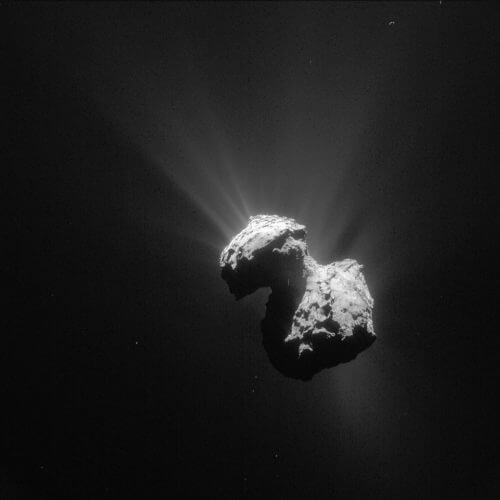
On August 4.8.2004, 67, the European Space Agency launched the Rosetta spacecraft towards comet XNUMXP or as it is named after its Russian explorers Churyumov-Gerosinnenko, a very complicated and difficult name to steer. A lander named Philae was also attached to the spacecraft. The spacecraft was designed to enter orbit around it and land a lander on it. This is a first attempt of its kind and extremely complicated. A comet like many of the asteroids is actually a flying mountain and is only a few kilometers in size. On large bodies such as moons and planets, if you miss the landing spot, you can land somewhere else - the diameter of the large bodies is hundreds and thousands of kilometers. But in the comets, the smallest miss means the miss of the target as a whole.
After a flight of 10 years on August 6.8.2014, 12.11.2014 the spacecraft entered orbit around the comet and on November 30.9.2016, XNUMX the lander was released for landing. The landing was not completely successful, although the lander managed to transmit a number of photographs to Israel and take a number of measurements. On September XNUMX, XNUMX, the spacecraft finished its mission and crashed on its surface.
The comet orbits the sun once every 6.4 years. Its epihelion is 850.15 million km and its perihelion is 186 million km and it rotates around itself once every 12.7 hours. The photographs showed that the comet was made of two parts and it is not clear how they were attached to each other. The smaller part measures 1.8 x 2.3 x 2.6 km and the larger part measures 1.8 x 3.3 x 4.1 km. The volume of the comet is 21.4 cubic km and its density is 0.53 g/cm4.5. It is estimated that the age of the comet is 1 billion years (2). The neck of the comet, the place where the two parts of the comet are connected to each other is brighter than the rest of its surface. It could be that the reason for this is a difference in the materials or the size of the grains (XNUMX).
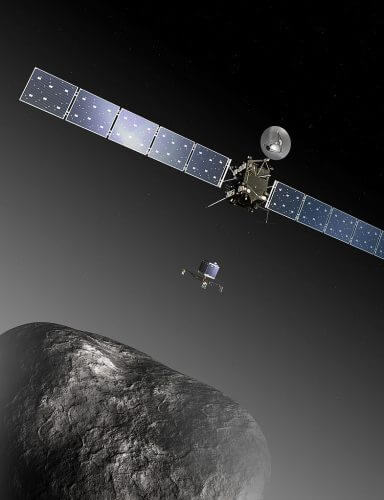
The photographs will corroborate earthly observations made before the launch of the spacecraft, according to which the comet does not reflect enough sunlight. Full reflection of sunlight can only exist when the surface is completely covered with ice (3). In the photographs you can see rocks, craters and slopes of steep rocks. Photographs taken between May and July 2015 reveal rounded formations in the large lobe of the comet in the area named Imhotep near the equator. In this area there are large rocks and smooth plains covered probably with granular sediments. Observations of this area are from August 2014 to May 2015. No changes were observed up to the order of 10 cm and one day the researchers noticed something new. Imhotep's surface began to change dramatically and it continued for some time. In such a small body a change of this magnitude is significant (4).
Where Philae landed the ground is as hard as ice (5). A total of 19 distinct areas were identified on the surface of the comet. They can be divided into 5 groups. Dust covered areas, brittle areas full of pits and circular structures, long depressions, smooth areas, and rocky areas. The thickness of the dust layer is probably several meters and it seems that these areas play an important role in insulating the interior of the comet and protecting the ice. It is possible to notice in various places small patches of ice on the order of 25-15 meters in size, parts of the walls of the exposed rocks are randomly covered with cracks and their origin is related to the rapid temperature changes due to the rate of rotation of the comet around itself. A prominent and curious crack is a slot parallel to the comet's neck and 500 meters long, although the reason for its formation is still not completely clear. There are very steep areas that are 3 meters long. which received the name goosebumps (goosebumps, bumps). Their origin is also unclear (6).
As for the grains, two types were distinguished. One type, the grains are tens of micrometers in diameter and the other type is 2 mm in diameter. These are very different. The very small grains of only a few micrometers found in the Hapi region in the neck of the comet. Different sizes indicate different ways of formation and different time frames needed for this. In the Hapi area the small grains are connected to a thin "frost" layer essentially as part of the daily ice cycle for the large grain layers in Imhotep a more complex history. It seems that their formation was slower and related only to erosion (7).
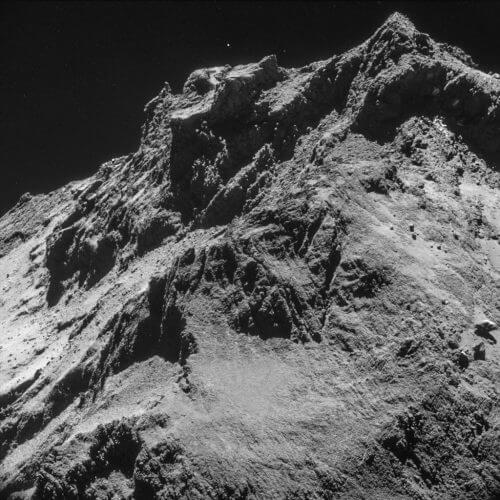
The researchers concluded that the comet is very porous, which weakens the bonds of the ice and dust masses and creates small spaces between them. This probably has something to do with the cracks that are visible on the surface _ the author's hypothesis - Haim Mazar). The cracks appear in random order and in different directions and are related to the heating and cooling cycles of the comet's surface both due to its rotation around itself and due to its orbit around the sun. Most likely this phenomenon is also common in other comets (author's hypothesis - Haim Mazar) (6). In the time gap between 2014 when a large crack in the neck was visible to August 2015, the time when the comet was in its perihelion, the crack observed in the neck lengthened by hundreds of meters and additional cracks were observed (8).
During the spacecraft's observations, many jet streams from the comet were seen. These jet streams contain gases and dust. At first glance one can distinguish different types of jet streams. There are individual jet streams, there are jet streams coming out from different points, facing each other and crossing each other (9) and there are some that are wide (10). The jets were observed in the neck and they were also seen bursting out of pits. The gases that break out play an important role in moving dust along the surface. They create dune-like ripples and rocks with a "wind tail". The rocks act as natural obstacles in the direction of the movement of the gas (6).
During the observations made between July and September 2014, the quantitative ratio between the comet's dust and gas was measured for the first time and it was found that the amount of dust is 4 times greater than that of the gas during the daytime hours of the comet. It was estimated that this ratio would change as the comet approached the sun. So more ice grains will be lifted up than dust grains. Another thing measured is the movement of the dust grains around the comet. Groups of dust grains were distinguished. One group flows out from the ground and is close to the spacecraft and the other surrounds the comet at a distance of no less than 130 km from it. It is estimated that as the gas to dust ratio increases, the interaction with charged particles from the solar wind and its ultraviolet radiation lead to the deepening of the comet's ionosphere and finally to the magnetosphere (6).
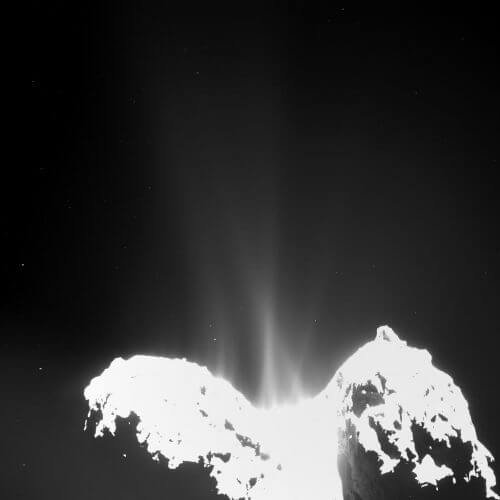
During the spacecraft's approach between July 21.7.2014, 13.7.2015 and July 68, 3, temperatures of the comet were measured. The average temperature was found to be XNUMX degrees Celsius below zero, a much higher temperature than expected if the comet was completely covered in ice. (XNUMX).
The water found on the comet is different from that known on Earth and the ratio of deuterium (an isotope of hydrogen) is different from that known in our world - it is more than 3 times greater. To date, only one comet has been found with the same ratio as that of Earth (11). The extent of casting the amount of water vapor increased from 0.3 liters per second at the beginning of June 2014 to 1.2 liters per second at the end of August 2014. The major part of this water is from the neck of the comet (6).
As the spacecraft approached the comet, more than 100 patches of ice several meters in size were discovered. Since the comet was moving towards the sun at that time, it was clear that this ice, as it approaches the sun, evaporates and while carrying away grains and together form the comet's corona (coma) and the tail. Even so, some of the dust remains on the ground during evaporation or falls back to the ground elsewhere and forms a thin layer of powdery material and leaves some exposed ice on the ground. This explains why this comet and others appear dark when spacecraft have passed near them.
Photographs taken in September 2014 identified 120 spots that are 10 times brighter than the average brightness of the surface. Some of these bright areas appear as rock clusters and others are isolated. The bright clusters are tens of meters in size and located at radii of tens of meters. They were probably formed as a result of erosion or rockslides that expose material found under the ice layer. In contrast to these clusters, some of the individual bodies are found in areas that have nothing to do with their surroundings. These are probably objects that were brought from another place on the comet during the comet's activity, but without the necessary speed to escape from its gravity. In any case, the bright areas that received a little energy from the sun are like shaded areas of a rock and no changes were noticed during the month in which they were observed. In visible light they appear blue compared to the red background found in other components of the ice. The best explanation for this is water. During this observation, the comet was far from the Sun, so the ice evaporation rate was less than 1 mm per hour (12).
A combination of all the measurements from all the spacecraft's instruments indicates an increase in water production from tens of thousands of tons per day when it first approached the comet in August 2014 to 100 million tons at the comet's perihelion in August 2015. In the months after perihelion, water production dropped sharply (13).
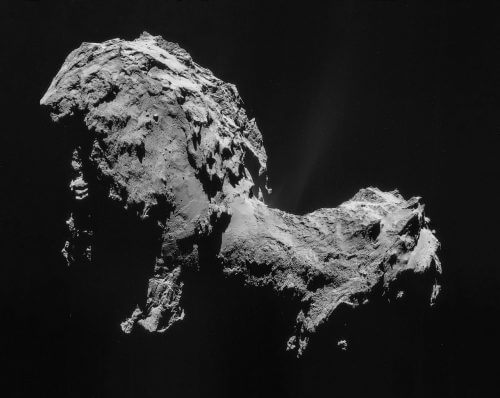
Contrary to what was thought in the comet's "atmosphere" molecular oxygen (O2) is found. Since oxygen tends to combine with other elements, the thought was that all the oxygen from the beginning of the formation of the solar system combined with hydrogen and resulted in the formation of water. According to various models, the oxygen should not have remained in the molecular state for a long time. It turned out that oxygen is the fourth most common element in the corona of the comet after water, CO and CO2. Molecular oxygen can be created in space through radiolysis. This process occurs when energetic particles from the sun break bonds of water ice. Experiments have shown that hydrogen can undergo diffusion leaving oxygen without any molecules. who created reactions with him. This move can occur on comets at most up to a depth of several meters below the ground. It turned out that the ratio of water to the "atmospheric" oxygen of the comet remained the same during the observations of the spacecraft, in light of the experiments in which the observations were made from the spacecraft, the conclusion reached is that molecular oxygen has been present in the comet since its formation. The obvious questions are two. The first question is what are the essential conditions for molecular oxygen in order for ice crystals to form in comets like this comet. The second question is how the oxygen remains so pure over time (14).
Organic compounds similar to carboxylic acids were discovered on the comet's surface, similar to amino acids that connect to each other to form proteins. The findings indicate the presence of organic molecules in the materials that make up the comet nucleus. The creation of these compounds requires the presence of volatile molecules such as methanol, methane and CO which freeze only at very low temperatures. The conclusion is that these molecules were formed very far from the sun in the first days of the formation of the solar system (15).
See more on the subject on the science website:
- Farewell to the comet lander, July 30, 2016
- Rosetta's comet contains ingredients necessary for life, January 25, 2015
- Kalim Churyomov in an interview with the scientist website: "I am happy that the European Space Agency chose a comet that I co-discovered as a target for the spacecraft", November 22, 2014
- The wisdom of the crowds helped discover the jump of the Philae lander and its final landing place on the comet, November 17, 2014
- ESOC director Paolo Perry in an interview with the science website: Rosetta is not a typical space mission, November 13, 2014
- Philae landed on its side and in a shady spot but managed to take and broadcast historical images of the ground of a comet nucleus from the surface; Fear of its ability to continue operating when the batteries run out, November 14, 2014
- European Space Agency control room director: "Philae on the comet" Update: apparently the anchors did not stick to the ground, November 12, 2014
Sources
1. Stephen Clark – "Rosetta sees surprising shape to spinning comet" 17.7.2014
2. 'Surface impression of Rosetta's comet" 29.7.2914
3. Stephen Clark – “Rosetta Targest comet too warm to be an icy world” 2.8.2014
4. Stephen Clark – "The surface of Rosetta's comet is changing" 19.9.2015
5. Stephen Clark – “Philae finds comet harbors organisms” 18.11.2014
6. 'Getting to know Rosetta's comet"23.1.2015
7. 'Exposed ice on Rosseta's comet confirmed on water” 14.1.2014
8. Christopher Crockett – “Comet 67P cracking under pressure” 18.10.2016
9. PIA18886 : Rosetta comet spreads its jets
10. "Comet activity on August 2014"
11. Stephen Clark – “Rosetta raises questions on how water got to Earth"11.12.2014
12. 'Exposed water ice detected on comet's surface"24.6.2015
13. 'Rosetta measures the production of water at the comet over two years"30.9.2016
14. Debora Debared Netburn – "Oxygen found on comet Rosetta mission' most surprising discovery...so far" 27.10.2015
15. Stephen Clark-"discoveries from Rosetta put comet 67p in focus" 26.1.2015
